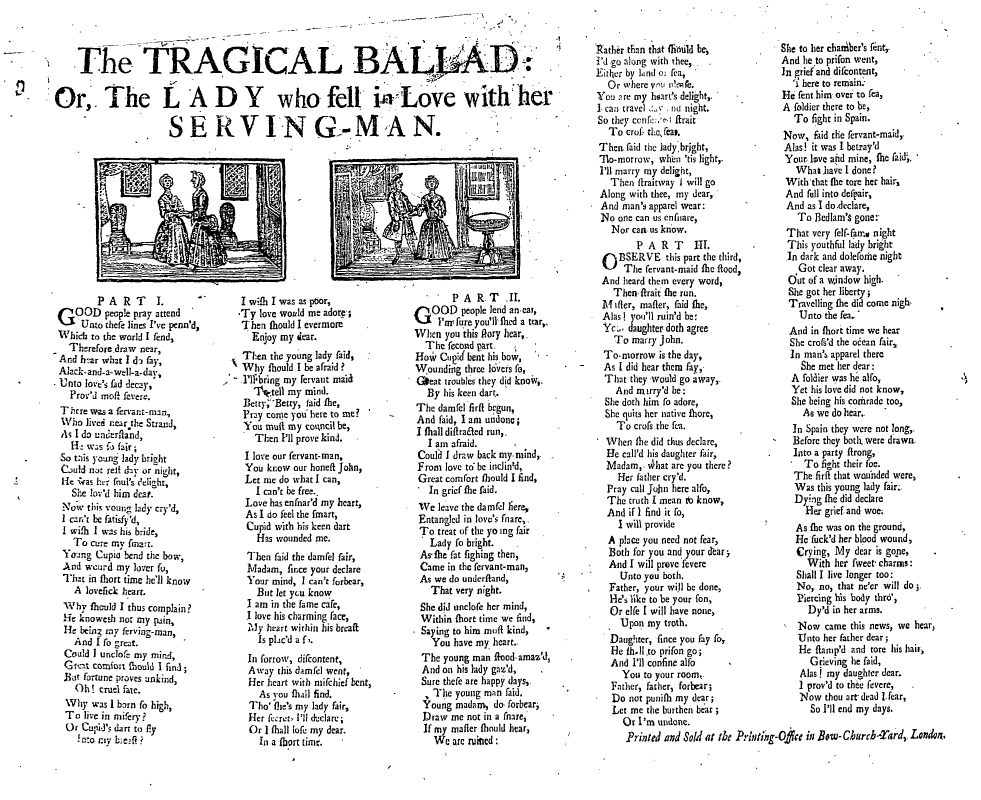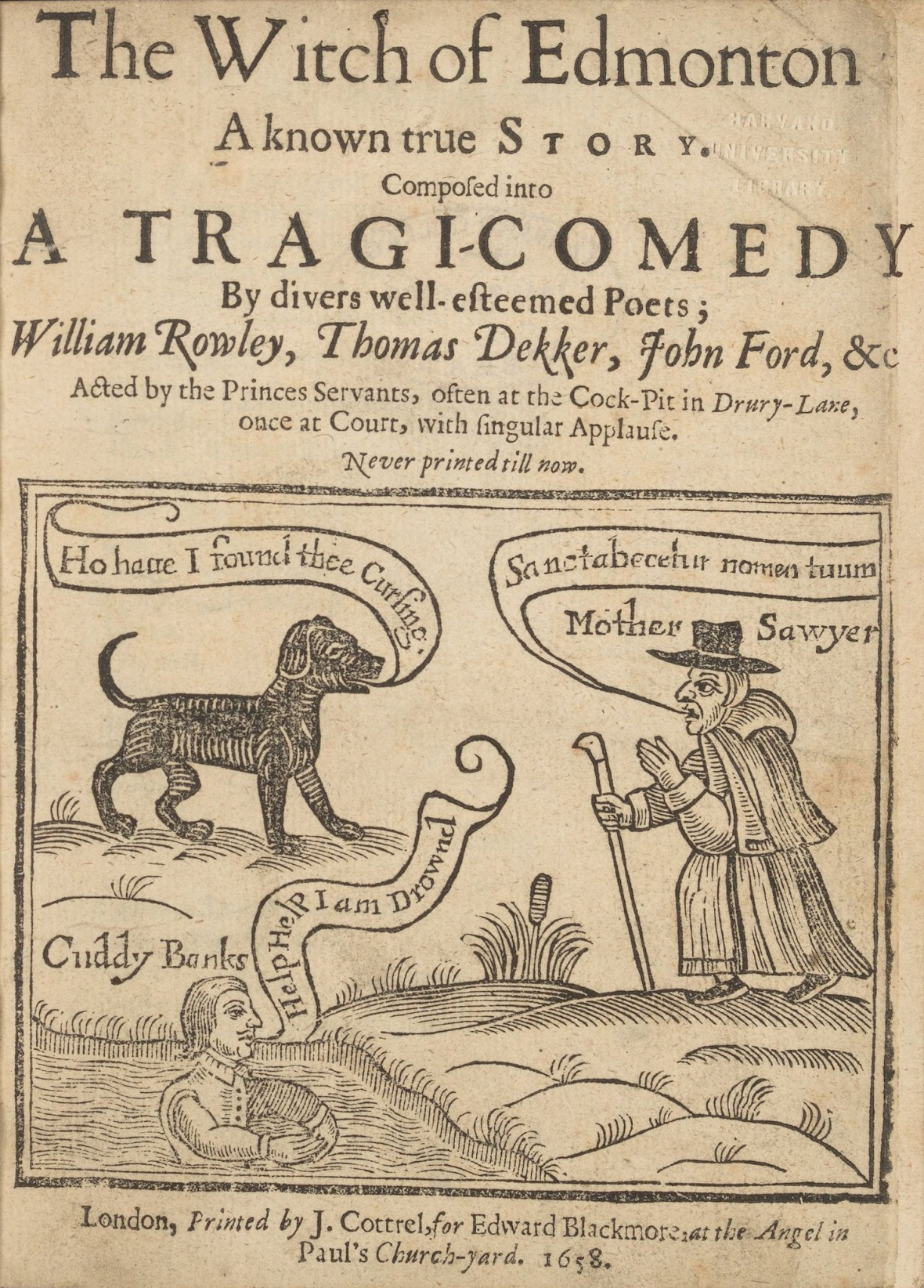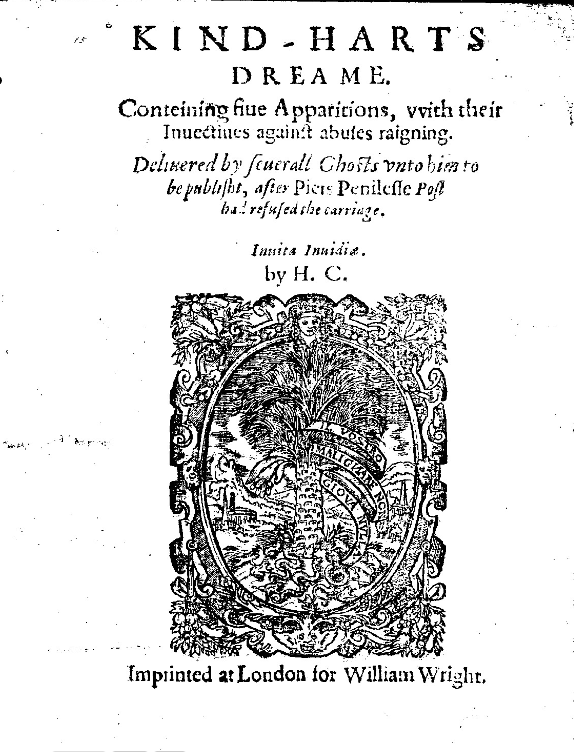|
Lady Isabel's Tragedy
Lady Isabel's Tragedy, or "The Lady Isabella's Tragedy; or, The Step-Mother's Cruelty" is a broadside ballad, which dates from, by estimation of the English Short Title Catalogue, as early as 1672 and as late as 1779—suggesting its popularity and positive reception. The ballad begins, "There was a Lord of worthy Fame." Copies of the ballad can be found at the National Library of Scotland, the British Library, University of Glasgow Library, the Huntington Library, and the Pepys Library at Magdalene College. Alternatively, online facsimiles of the ballad are available for public consumption at sites like the English Broadside Ballad Archive. The ballad has notable connections to the stories of Snow White, the myth of Philomela, and Titus Andronicus. Tune Extant copies of "The Lady Isabella's Tragedy," found at the English Broadside Ballad Archive of University of California, Santa Barbara, are set to the tune of "The Lady's Fall"/"The Ladies Fall"—a popular tune in the seventee ... [...More Info...] [...Related Items...] OR: [Wikipedia] [Google] [Baidu] |
Broadside Ballad
A broadside (also known as a broadsheet) is a single sheet of inexpensive paper printed on one side, often with a ballad, rhyme, news and sometimes with woodcut illustrations. They were one of the most common forms of printed material between the sixteenth and nineteenth centuries, particularly in Britain, Ireland and North America because they are easy to produce and are often associated with one of the most important forms of traditional music from these countries, the ballad. Development of broadsides Ballads developed out of minstrelsy from the fourteenth and fifteenth century. These were narrative poems that had combined with French courtly romances and Germanic legends that were popular at the King’s court, as well as in the halls of lords of the realm. By the seventeenth century, minstrelsy had evolved into ballads whose authors wrote on a variety of topics. The authors could then have their ballads printed and distributed. Printers used a single piece of paper known as ... [...More Info...] [...Related Items...] OR: [Wikipedia] [Google] [Baidu] |
Titus Andronicus
''Titus Andronicus'' is a Shakespearean tragedy, tragedy by William Shakespeare believed to have been written between 1588 and 1593, probably in collaboration with George Peele. It is thought to be Shakespeare's first tragedy and is often seen as his attempt to emulate the violent and bloody revenge plays of his contemporaries, which were extremely popular with audiences throughout the 16th century. Titus Andronicus (character), Titus, a Legatus, general in the Roman army, presents Tamora, Queen of the Goths, as a slave to the new Roman emperor, Saturninus. Saturninus takes her as his wife. From this position, Tamora vows revenge against Titus for killing her son. Titus and his family retaliate. ''Titus Andronicus'' was initially very popular, but by the later 17th century it was not well esteemed. The Victorian era disapproved of it, largely because of its graphic violence. Its reputation began to improve around the middle of the 20th century,Massai (2001: xxi) but it is stil ... [...More Info...] [...Related Items...] OR: [Wikipedia] [Google] [Baidu] |
William Chappell (writer)
William Chappell (20 November 180920 August 1888) was an English writer on music, a partner in the London musical firms of Chappell & Co. and, later, Cramer & Co. Biography He was born in London on 20 November 1809. His father, Samuel Chappell, soon after the son's birth, entered into partnership with Johann Baptist Cramer and F. T. Latour, and opened a music publishing business at 124 New Bond Street. In 1826, he became sole partner, and in 1830 was established at 50 New Bond Street, where he died in December 1834. William, his eldest son, then managed the business for his mother until 1843. Chappell began the study of English folk-tunes and ballads. In 1838, he issued his first work, ''A Collection of National English Airs, consisting of Ancient Song, Ballad, and Dance Tunes,'' in two volumes, one containing 245 tunes, the second some elucidatory remarks and an essay on English minstrelsy. The airs were harmonised by Macfarren, Dr. Crotch, and Wade; only Macfarren's wer ... [...More Info...] [...Related Items...] OR: [Wikipedia] [Google] [Baidu] |
Thomas Dekker (poet)
Thomas Dekker (c. 1572 – 25 August 1632) was an English Elizabethan dramatist and pamphleteer, a versatile and prolific writer, whose career spanned several decades and brought him into contact with many of the period's most famous dramatists. Early life Little is known of Dekker's early life or origins. From references in his pamphlets, Dekker is believed to have been born in London around 1572, but nothing is known for certain about his youth. His last name suggests Dutch ancestry, and his work, some of which is translated from Latin, suggests that he attended grammar school. Career Dekker embarked on a career as a theatre writer in the middle 1590s. His handwriting is found in the manuscript of '' Sir Thomas More'', though the date of his involvement is undetermined. More certain is his work as a playwright for the Admiral's Men of Philip Henslowe, in whose account book he is first mentioned in early 1598. While there are plays connected with his name performed as early ... [...More Info...] [...Related Items...] OR: [Wikipedia] [Google] [Baidu] |
Henry Chettle
Henry Chettle (c. 1564 – c. 1606) was an English dramatist and miscellaneous writer of the Elizabethan era, best known for his pamphleteering. Early life The son of Robert Chettle, a London dyer, he was apprenticed in 1577 and became a member of the Stationer's Company in 1584, traveling to Cambridge on their behalf in 1588. His career as a printer and author is shadowy. He may have set up some of the tracts printed in response to Martin Marprelate. In 1591, he entered into partnership with William Hoskins and John Danter, two stationers. They published a good many ballads, and some plays, including a surreptitious and botched first quarto of ''Romeo and Juliet'', to which it is suggested Chettle added lines and stage directions. ''The Groat's-Worth of Wit'' In 1592 ''Greene's Groats-Worth of Wit'', supposedly the work of the recently deceased, and very popular, Robert Greene, was published, having been entered in the register of the Stationer's Company "at the peril of H ... [...More Info...] [...Related Items...] OR: [Wikipedia] [Google] [Baidu] |
The Stepmother's Tragedy
''The Stepmother's Tragedy'' is a play written by Henry Chettle Henry Chettle (c. 1564 – c. 1606) was an English dramatist and miscellaneous writer of the Elizabethan era, best known for his pamphleteering. Early life The son of Robert Chettle, a London dyer, he was apprenticed in 1577 and became a m ... and Thomas Dekker. It is mentioned in Philip Henslowe's diary in August 1599. No extant copies of the play are known. British plays 1590s plays Lost plays {{16thC-play-stub ... [...More Info...] [...Related Items...] OR: [Wikipedia] [Google] [Baidu] |
Scullion
Scullion may refer to: * The Irish surname derived from 'Ó Scolláin' meaning 'descendant of the/a scholar' * a servant from the lower classes. Music * Scullion (group), an Irish folk rock band * ''Scullion'' (album) People with the surname * Liam Scullion (born 2001), Scottish footballer *Michelle Scullion (born 1957), New Zealand musician and composer *Nigel Scullion, Australian politician *Stephen Scullion, Northern Irish runner *Tony Scullion Tony "The Tiger" Scullion (born 6 February 1962) is a former dual player of Gaelic games who played Gaelic football and hurling with Derry in the 1980s and 1990s. He is chiefly known as a footballer and was part of Derry's 1993 All-Ireland Cham ..., Irish Gaelic footballer See also * Skullion - the main character in the novels ''Porterhouse Blue'' and ''Grantchester Grind'' {{disambiguation, surname ... [...More Info...] [...Related Items...] OR: [Wikipedia] [Google] [Baidu] |
The Ballad Of Chevy Chase
"The Ballad of Chevy Chase" is an English ballad, catalogued as Child Ballad 162 (Roud 223Sehere/ref>). There are two extant ballads under this title, both of which narrate the same story. As ballads existed within oral tradition before being written down, other versions of this once-popular song also may have existed. Its tune has been used by other, unconnected songs. Synopsis The ballads tell the story of a large hunting party upon a parcel of hunting land (or ''chase'') in the Cheviot Hills, a range of rolling hills straddling the Anglo-Scottish border between Northumberland and the Scottish Borders—hence, Chevy Chase. The hunt is led by Percy, the English Earl of Northumberland, against the wishes of the Scottish Earl Douglas, who had forbidden it. Douglas interprets the party's arrival as an invasion of Scotland and attacks. Only 110 people survive the bloody battle that follows. Historical basis Percy and scholar Francis J. Child noted similarities with the older ... [...More Info...] [...Related Items...] OR: [Wikipedia] [Google] [Baidu] |
University Of California, Santa Barbara
The University of California, Santa Barbara (UC Santa Barbara or UCSB) is a Public university, public Land-grant university, land-grant research university in Santa Barbara County, California, Santa Barbara, California with 23,196 undergraduates and 2,983 graduate students enrolled in 2021–2022. It is part of the University of California 10-university system. Tracing its roots back to 1891 as an independent teachers' college, UCSB joined the University of California system in 1944, and is the third-oldest undergraduate campus in the system, after University of California, Berkeley, UC Berkeley and University of California, Los Angeles, UCLA. Located on a WWII-era Marine air station, UC Santa Barbara is organized into three undergraduate colleges (UCSB College of Letters and Science, College of Letters and Science, UCSB College of Engineering, College of Engineering, College of Creative Studies) and two graduate schools (Gevirtz Graduate School of Education and Bren School of E ... [...More Info...] [...Related Items...] OR: [Wikipedia] [Google] [Baidu] |
Philomela
Philomela () or Philomel (; grc-gre, , ; ) is a minor figure in Greek mythology who is frequently invoked as a direct and figurative symbol in literary and artistic works in the Western canon. Family Philomela was the younger of two daughters of Pandion I, King of Athens, and the naiad Zeuxippe. Her sister, Procne, was the wife of King Tereus of Thrace. Philomela's other siblings were Erechtheus, Butes and possibly Teuthras. Mythology While the myth has several variations, the general depiction is that Philomela, after being raped and mutilated by her sister's husband, Tereus, obtains her revenge and is transformed into a nightingale (''Luscinia megarhynchos''), a bird renowned for its song. Because of the violence associated with the myth, the song of the nightingale is often depicted or interpreted as a sorrowful lament. In nature, the female nightingale is actually mute, and only the male of the species sings. Ovid and other writers have made the association that the ... [...More Info...] [...Related Items...] OR: [Wikipedia] [Google] [Baidu] |
English Short Title Catalogue
The English Short Title Catalogue (ESTC) is a union short-title catalogue of works published between 1473 and 1800, in Britain and its former colonies, notably those in North America, and primarily in English, drawing on the collections of the British Library and other libraries in Britain and around the world. It is co-managed by the British Library and the Center for Bibliographical Studies and Research (CBSR) at the University of California, Riverside. The database is freely searchable. History The ESTC began life as the Eighteenth-Century Short Title Catalogue, with the same abbreviation, covering only 1701 to 1800. Earlier printed works had been catalogued in A. W. Pollard and G. R. Redgrave's ''Short Title Catalogue'' (1st edn 1926; 2nd edn, 1976–91) for the period 1473 to 1640; and Donald Goddard Wing's similarly titled bibliography (1945–51, with later supplements and addenda) for the period 1641 to 1700. These works were eventually incorporated into the database. ... [...More Info...] [...Related Items...] OR: [Wikipedia] [Google] [Baidu] |

.jpg)





